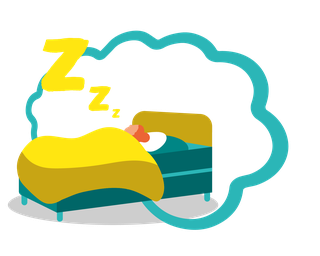Tackling your worries
Worrying is part of life. We cannot eliminate it completely or control everything, but if your worries feel overwhelming there are lots of things you can try to manage or overcome them, including the "worry time" technique.
Find out about worry time, as well as plenty more practical tips and strategies you can try to help you tackle your worries.
Video: Tackling your worries
This video takes you through the "worry time" technique, and other tips and strategies to help you better manage your worries.
Steps and strategies to tackle your worries

1. Write them down
Sometimes just getting things out of your head and down onto paper or a notes app on your phone can help you clear your mind and make it easier to work through concerns one by one.

2. Set aside 'worry time'
If you find that your worries are taking over your day, it can help to try to manage this by setting yourself some "worry time” – a short period, say 10 or 15 minutes, every day or so before bed to write things down and try to find solutions.
Making this a regular thing can help put your mind at ease and stop your thoughts racing when you're trying to sleep.

3. Do not dwell during the day
Once we have a regular worry time, this can help prevent us from getting lost in our worries during the rest of the day.
So when a worry does enter your mind, think "I'll set that aside for my worry time." This can help you shift your focus back to the here and now.
It might feel difficult at first to stop your thoughts from returning to the worry, but as time goes on and you settle into the habit of having worry time, it should get easier.

4. Use the 'worry tree'
When you sit down to think about your worries, a structured technique called the "worry tree" can help keep you focused on understanding the difference between problems you can solve and hypothetical worries that are beyond your control.
It can also help you decide what you can act on immediately or whether something needs to be scheduled and acted on later.

5. Make a plan – and carry it out
Once you have caught and checked the worry, ask yourself: "Is there anything practical I can do about it?"
For worries you can do something about, write down a plan of action.
Try to make this as specific as possible. Answering these questions might help:
- What would you do?
- How could you do it?
- When would you do it?
If you have identified anything it would be possible to do right now, make sure you do it.
If the worry returns, you can then remind yourself you have already taken action and try to shift your focus.
If there's nothing you can do for the moment, schedule a time for when you can and will. Then if the worry bubbles back up, remind yourself you have a plan in place, and try to switch your attention to something else.

6. Accept the worries you cannot control and move on
Worrying is part of life. We cannot eliminate it completely or control everything. For any worries you have identified as ones you cannot do anything about, try to acknowledge and accept this.
Often, even just knowing we've spent time thinking about a worry properly and assessing the options can help dampen them.
Try not to dwell on one worry for too long – either move on to dealing with another, or find ways to shift your focus, distract yourself, relax or clear your mind.

8. Focus on the present
In time, following these steps should make it easier to deal with the worries we can do something about and stop the ones we cannot from becoming overwhelming.
But if anxiety is creeping in, it's really useful to have some go-to strategies – like exercise, yoga, or breathing, mindfulness or meditation techniques – to help calm us down and bring us back to the present moment.
These can take time and practice to get used to, but they really can help you feel more in control of your thoughts and feelings.
You could also try an app, an NHS audio guide, or a book from your local library from the Reading Well list of mental health books.
It's worth giving things a go and seeing what works best for you.
Video: Mindful breathing
Mindfulness and meditation help you to be in the present. The mindful breathing exercise in this video can help you feel calmer.
More self-help CBT techniques you can try

Problem solving
Learning new ways to work through your problems can make them feel more manageable, and improve your mental and physical wellbeing.
Find more ideas to try in self-help CBT techniques


